So, you’ve built your service marketplace — congrats! You’ve figured out your core features, got your MVP up and running, and maybe even landed your first few users. But now, you’re staring down the next big mountain: growth, scaling, and making real money.
This is where the magic happens — or where things can totally fall apart.
Phase 3 of your marketplace journey is what we call the “Decision Stage.” It’s when you stop experimenting and start focusing. You’re choosing your tech stack, defining your growth channels, building referral loops, automating processes, and — oh yeah — figuring out how to monetize.
The good news? You’re not alone, and there’s a roadmap.
In this post, we’ll show you:
- How to get your first 1,000 loyal users using powerful, proven marketing tactics.
- The overlooked challenges of scaling a two-sided marketplace — and how to sidestep them.
- How to bake growth into your product using platforms like Dittofi.
- Real-life stories of service marketplaces that crushed it (and what you can steal from them).
Let’s get into it.
Why Hitting Your First 1,000 Users Matters More Than You Think
You’ve probably heard it a million times: “Get your first 1,000 users and the rest will follow.” But what no one tells you is that getting there is grueling, especially when you’re building a two-sided platform where both sides — supply and demand — have to grow at the same time.
So why is this milestone so important?
Because your first 1,000 users are your beta testers, your brand advocates, and your early data points. They’ll tell you what’s broken, what they love, and what they’ll actually pay for. Without them, you’re flying blind.
Here’s what you need to focus on:
- Who are they? Hone in on your early adopters. They’re not just “anyone” who uses your service — they’re the ones who need it now.
- What’s the hook? You need a compelling value proposition that grabs attention. Your messaging should scream, “This is exactly what I’ve been looking for!”
- How will they spread the word? The best early users talk. If you build the right experience (with some smart nudges), they’ll bring others along for the ride.
But how do you get them? That’s where smart marketing comes in — let’s break it down.
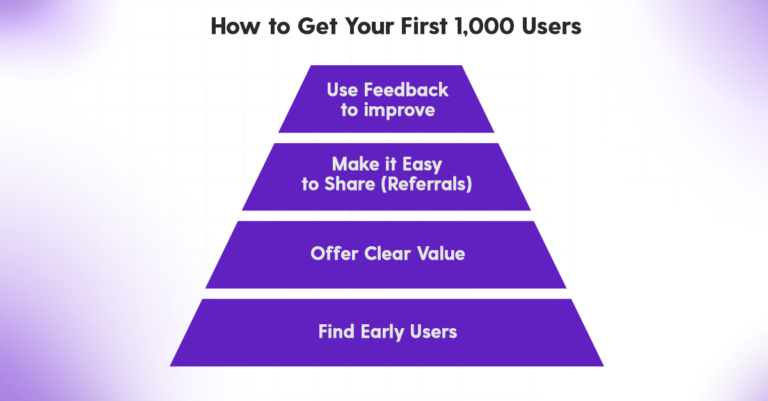
SEO: Strategy That Brings Users in While You Sleep
If you’re playing the long game — and you should be — Search Engine Optimization (SEO) isn’t optional. It’s your free, always-on traffic generator that brings in users exactly when they’re looking for you.
But let’s get real. SEO isn’t about stuffing keywords and waiting for Google to work magic. It’s about solving real problems with high-quality content that earns trust and clicks.
Start with search intent:
- What are people actually typing into Google?
- What pain points are they trying to solve?
- How does your marketplace fit into that search?
Let’s say you’re launching a freelance pet-sitting marketplace. People might search:
- “Pet sitters near me”
- “How to find a reliable dog walker”
- “Affordable pet sitting in Edmonton”
That’s your content roadmap.
Now, let’s talk about how to actually make SEO work for your marketplace.
Start by creating targeted landing pages for each service you offer, especially if you’re covering multiple locations. Instead of one generic page, have a dedicated space for “Plumbers in Edmonton” or “Dog Walkers in Montreal.” This helps Google understand exactly what you’re offering and where.
Next, focus on writing helpful, well-researched blog posts that answer the questions your potential users are already searching for. Think of things like “How to find a reliable babysitter in Spruce Grove” or “Best time to schedule a home cleaning.” These kinds of posts build trust and authority — and they bring the right people to your site.
Don’t forget the technical side either. Adding schema markup to your listings can make your pages show up with fancy rich results — like star ratings, reviews, and pricing info — right in the search engine results. It makes your marketplace stand out and boosts click-through rates.
And lastly, build credibility by earning backlinks. Reach out to bloggers in your niche, write guest posts, contribute to roundups, and get your platform mentioned on local news or industry websites. These links not only bring in traffic but also tell Google that your site is trustworthy.
All of these strategies compound over time. They help you climb the rankings and make sure your platform is front and centre when your future users hit “search.”
SEO isn’t quick, but it pays off massively over time. Once your content starts ranking, it continues to drive traffic 24/7 — without burning a hole in your ad budget.
Pro tip: Make your blog actionable. Add checklists, templates, even calculators related to your niche. These become link magnets and give users a reason to come back.
Leverage Dittofi for SEO:
- Use Dittofi’s capabilities to create dozens of SEO-optimized pages effortlessly.
- Integrate with analytics tools to track rankings and keyword performance.
- Add lead capture forms to blog posts and route them to automated email journeys using Dittofi’s built-in growth tools.
Remember, SEO is your slow-cooked stew — it takes time, but when it’s ready, it feeds your entire growth engine.
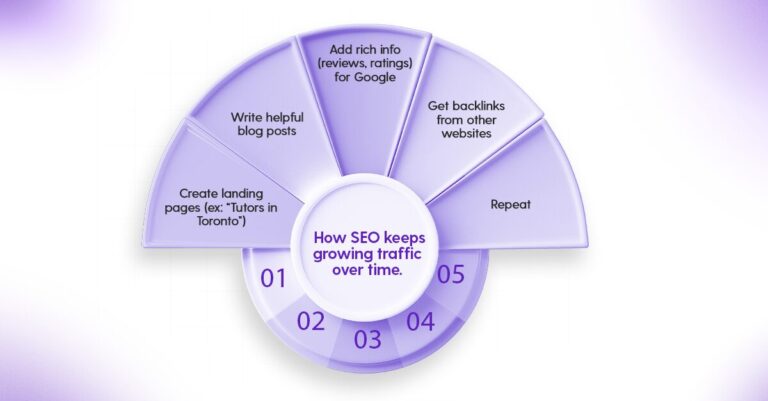
Paid Ads: A Playbook for Fast User Growth
Let’s be real — organic growth is amazing, but it’s not always fast. And when you’re just launching your service marketplace, you don’t have months to wait for SEO to kick in or for word-of-mouth to catch fire. You need users, and you need them now.
That’s where paid advertising comes into play. And no, it doesn’t have to be scary or wildly expensive. In fact, when done strategically, ads can be one of the most efficient, ROI-positive ways to kickstart your growth engine and fill those early supply and demand gaps.
But before you start throwing money at every platform, take a breath. The key is choosing the right place to advertise based on who your audience is and where they’re spending their time.
Let’s break it down:
- Google Ads are fantastic if you’re targeting high-intent searches. Think about someone Googling “hire a dog walker in Toronto” or “book a handyman near me.” These people are ready to convert — they just need to find you first.
- Meta (Facebook & Instagram) gives you a powerful mix of visual storytelling and laser-sharp targeting. Whether you’re retargeting people who visited your site or launching campaigns to attract lookalike audiences, it’s ideal for brand-building and nurturing interest.
- TikTok Ads? Huge if your marketplace leans toward Gen Z or lifestyle categories. Whether it’s fitness coaches, dog groomers, or hair stylists, TikTok’s native feel and viral potential can explode brand awareness fast — if you get the creative right.
- LinkedIn Ads might be pricey, but if your marketplace connects professionals (think freelancers, consultants, coaches), it’s a goldmine. The audience there is primed for B2B discovery and serious about spending.
Once you’ve picked your channels, make sure every dollar is doing real work. Start with clear goals. Are you trying to get sign-ups? Bookings? App installs? Don’t fall into the trap of optimizing for clicks if what you really care about is paying customers.
Also, get comfortable with A/B testing. Try different versions of your ad copy, imagery, and calls-to-action. You might be surprised at what performs best. Let the numbers guide you — not your assumptions.
And here’s a pro tip: retargeting is your best friend. Most people won’t convert on their first visit, but if you follow up with the right message — maybe a testimonial, limited-time offer, or a reminder of what they left in their cart—they’re far more likely to come back and commit.
Even when you’re paying for traffic, users want to feel like they’re discovering something valuable — not just being sold to. So make sure your landing pages are polished, personal, and focused on what’s in it for them. Be human. Be clear. Be generous with your values.
Paid ads aren’t just about reaching people — they’re about reaching the right people, in the right way, at the right time. Nail that, and they’ll show up ready to act.

Influencer Marketing: The Secret to Instant Credibility
Let’s be honest: when was the last time you clicked on an ad and immediately trusted what it was selling? Probably not recently. Now, think about the last time a friend, favourite creator, or someone you follow online mentioned a tool or service they love — you were curious, right? Maybe even convinced to check it out.
That’s the magic of influencer marketing. It’s not just about reach — it’s about credibility. When someone you already trust introduces you to something new, it doesn’t feel like marketing. It feels like a recommendation. And in a noisy online world, that kind of authenticity is worth its weight in gold.
Here’s the best part: you don’t need a Kardashian-sized budget to tap into this power. Micro-influencers — folks with anywhere from 5,000 to 50,000 followers — often deliver better results than massive accounts. Why? Because their audiences are engaged, loyal, and niche-specific. They talk to communities, not crowds.
So how do you actually make influencer marketing work for your service marketplace?
Start by finding the right people. Look for creators who already align with your niche or audience. If you’re building a home-cleaning platform, maybe it’s local lifestyle bloggers or family-focused Instagrammers. If it’s a freelance marketplace, check out tech YouTubers or productivity-focused creators. You can use tools like BuzzSumo or HypeAuditor — or just spend some time digging through hashtags and community forums.
Then, make your offer meaningful. Influencers can smell a lazy pitch from a mile away. Instead of asking for a quick shoutout, offer something that gets them excited — free services, early access to features, a revenue share on referrals, or even creative freedom to design their own campaign.
And finally, think beyond the one-off post. The real magic happens when you co-create content — maybe it’s a behind-the-scenes demo, a Q&A about how they use your platform, or a giveaway that invites their audience to engage. When influencers feel invested, they don’t just promote — you become part of their story.
Influencer marketing isn’t about faking authenticity. It’s about finding the people who already speak your audience’s language — and giving them the tools to tell your story in a way that feels natural.
In a world where trust is everything, influencers don’t just drive clicks — they build belief. And when you’re just getting your marketplace off the ground, that’s worth far more than any billboard or banner ad ever could.
Referral Loops: Growth on Autopilot
Let’s talk about virality. No, not the TikTok kind (though that helps too) — built-in referral loops.
This isn’t some tech bro fantasy. It’s how companies like Dropbox, Airbnb, and Uber actually exploded — not just through clever ads or huge budgets, but by turning every happy customer into a mini-marketing machine.
Think about it: someone has a great experience on your platform, tells a friend, that friend signs up and tells two more people, and boom — your user base is growing on autopilot.
But it’s not magic. It’s an intentional design.
The best referral programs aren’t just lucky — they’re crafted to make sharing feel natural and rewarding. It starts with the right incentive. Maybe that’s a $10 credit, a free service, or access to exclusive perks. Whatever it is, it needs to feel genuinely valuable to your users.
Then there’s the experience itself. No one wants to jump through hoops just to refer a friend. Make it easy—like one-click easy. The more seamless and mobile-friendly the process, the more likely people are to actually share.
And don’t underestimate the power of urgency or even a little friendly competition. A referral campaign with a countdown — like “Invite 3 friends by Friday and get early access to our premium features”—can turn a passive user into someone actively bringing new people in.
When done right, referral loops are like a growth engine that never sleeps. They reduce your reliance on paid ads, build community vibes, and bring in users who already trust you—because someone they know gave you a thumbs up.
And the best part? You can build all of this directly into your platform using tools like Dittofi. It gives you everything from referral tracking to automated rewards without the usual tech headaches. So while others are burning through ad dollars, you’re building a user base that grows itself.
From dynamic SEO pages to influencer campaigns and automated referrals, Dittofi can give you the growth tools you need — without the tech headaches. If you’re serious about getting your first 1,000 users, don’t just hustle harder — build smarter.
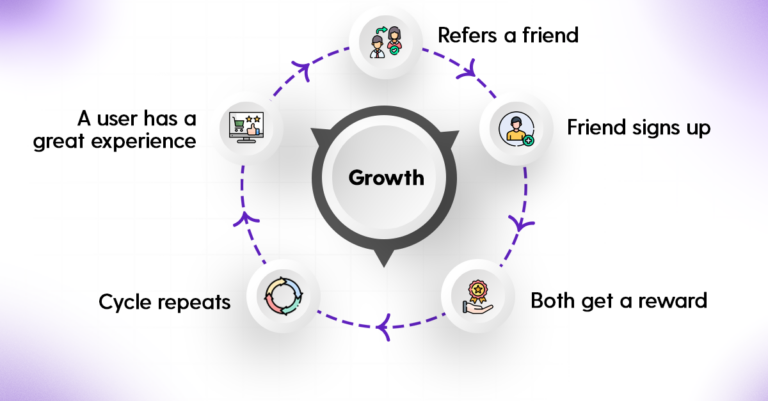
What Kills Marketplace Growth After 1,000 Users — And How to Survive It
Let’s bust a myth that trips up way too many marketplace founders: just because you’ve found early traction doesn’t mean you’re ready to scale. In fact, scaling is often where things start to wobble. It’s not that your idea isn’t good anymore — it’s just that the game changes, and the old playbook doesn’t work at the next level.
When you’re starting out, things are scrappy. You’re doing manual onboarding, maybe hand-picking providers, answering support emails yourself, and somehow, it works. But fast forward to 5,000 users — or 50,000 — and suddenly the cracks start to show.
Let’s break it down.
The Balance Problem: Supply vs. Demand
First up is the age-old chicken-and-egg problem: keeping supply and demand in sync. Early on, you could juggle it with some clever incentives and close relationships. But as you scale, it gets way harder. Add a new city or service category and suddenly you’re staring at empty listings or overbooked providers.
If your users can’t find what they need — or if your providers aren’t getting enough bookings — they’ll leave. It’s a delicate dance that needs constant tuning. And the tough part? You can’t just clone what worked in one region and expect it to work everywhere else. Each new market might have its own quirks, behaviours, even cultural expectations.
The Quality Trap: Scaling Without Slipping
Then comes the issue of quality. When you had 100 users, it was easy to know who your best providers were. You could personally step in if something went wrong. But now? One bad experience can turn into a bad review, which can turn into lost trust, which can snowball into churn.
That’s why the best marketplaces don’t just grow — they build systems to support their growth. Think about how platforms like Airbnb have verification systems, trust scores, user reviews, and safety guarantees baked right in. You’ll need to start thinking about things like structured onboarding, consistent review moderation, and clear dispute resolution processes. These aren’t nice-to-haves anymore — they’re survival tools.
The Ops Breakdown: Manual No More
And let’s talk about operations for a second. At scale, manual anything becomes a liability. Whether it’s onboarding, support, scheduling, or payments, the more you rely on human hands, the more room you leave for mistakes — and burnout.
This is where having the right tech stack makes all the difference. A platform like Dittofi can be a game-changer here. You can set up automated onboarding workflows for providers, trigger real-time alerts if something unusual happens (like a spike in cancellations), and use built-in dashboards to monitor key performance metrics — without hiring a full-time ops team to babysit it all.
And honestly, that’s the real lesson here: growth doesn’t just scale your wins — it also scales your weaknesses. What feels like a minor inefficiency at 100 users can become a massive sinkhole at 10,000. So the sooner you start building for scale — with the right systems and tools—the smoother the ride will be when that growth wave hits.
Scaling isn’t just about “more” — it’s about better. Smarter. Sustainable.
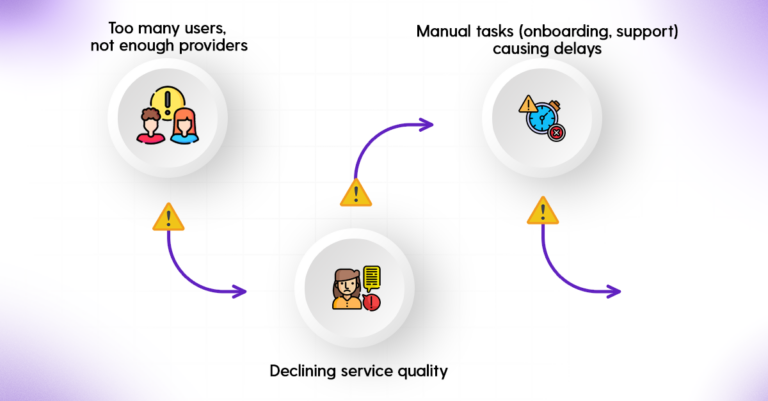
Building Trust at Scale
Trust is the lifeblood of service marketplaces. Without it, people simply won’t transact. In the early days, your personal touch or community vibes might build that trust. But at scale? You need systems that make trust predictable and repeatable.
Here’s how to build trust into your marketplace’s DNA:
1. Verified Profiles
The first step is transparency. Service providers should have clear, verifiable identities. Think:
- Background checks
- Certifications
- ID verification
Platforms like Dittofi can integrate third-party tools like Stripe Identity or Checkr for automated verification pipelines.
2. Ratings and Reviews
A solid review system is non-negotiable. But don’t stop at star ratings—go deeper. Enable:
- Written feedback
- Tag-based ratings (e.g., “punctual,” “friendly,” “clean tools”)
- Provider responses
Dittofi’s component system lets you build fully customizable review flows, so you’re not stuck with generic templates.
3. Secure Payments and Escrows
No one wants to get ghosted after paying — or delivering a service. Implement escrow payments to hold funds securely until both parties are satisfied.
This adds a layer of financial trust that’s crucial for both sides of your marketplace.
4. Fast Support & Dispute Resolution
Trust also comes from knowing someone has your back. That means:
- In-app chat support
- Quick refund options
- Escalation paths
All of this can be automated and managed with Dittofi, making support easier to scale.
Bottom line: the more you grow, the more structure and clarity your users will demand. Build it early, and your scaling process will be a lot smoother.
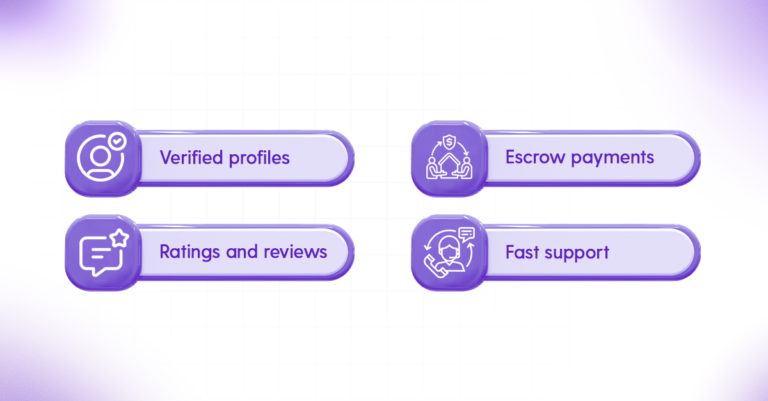
Smart Automation for Operations
If you’re relying on spreadsheets, Slack pings, and elbow grease to run the show, here’s the harsh truth — you are the bottleneck. And as your platform grows, those cracks will turn into canyons.
But here’s the flip side: when you set up smart systems that do the heavy lifting for you, your business becomes incredibly scalable. Things that used to take hours now happen in seconds. It’s like flipping a switch and watching your platform start to run itself.
So, what does automation actually look like in a marketplace setting? Let’s walk through a few areas where it makes a massive difference:
Onboarding That Feels Effortless
First impressions matter. When new users — whether they’re service providers or customers — sign up, you want them to feel like the red carpet just rolled out for them. That means more than just a welcome email. It’s about guiding them through setup, showing them what to do next, and giving them confidence that they’re in the right place.
With Dittofi, you can automate the entire onboarding flow. Trigger checklists, send timely nudges when someone drops off halfway through profile creation, and even offer mini product tours that explain how to get the most out of your marketplace.
Booking & Scheduling Without the Headaches
Manual scheduling is one of those tasks that seems manageable — until it’s not. Once you’re dealing with hundreds of providers and thousands of users, the back-and-forth emails become a nightmare.
Instead, plug in smart scheduling. Use real-time calendar integrations (Google Calendar, iCal, etc.), availability logic, and automated confirmations to streamline the whole experience. Dittofi supports this out of the box and plays nicely with third-party APIs, so you can handle even the most complex bookings without breaking a sweat.
Communication That Scales with You
One of the first things that cracks when you start to grow? Your communication flow. You go from manually sending follow-up emails to wishing you had five clones just to keep up.
That’s where automated messaging becomes your best friend. Set up sequences that nurture new users, re-engage cold leads, send appointment reminders, and even follow up post-service to ask for reviews. With Dittofi’s visual automation builder, you can create powerful email and SMS journeys that feel personal — even though they’re hands-off.
Data That Drives Smarter Decisions
As your user base grows, you need visibility into what’s working and what’s falling apart. And no, staring at random spreadsheets doesn’t count.
Automated analytics dashboards give you the insights you need to make informed decisions — fast. Want to know your conversion rates, which providers are most active, or how many support tickets are piling up? Set it up once, and let real-time reports keep you in the loop.
At the end of the day, this is what separates marketplaces that grow from those that just grind: systems that scale. The goal isn’t to work harder — it’s to work smarter, so your platform can grow without requiring you to clone yourself ten times over.
And when it’s all humming in sync — users getting onboarded, bookings flowing, messages firing off, data lighting up dashboards — it’s like your marketplace comes alive. Responsive, personalized, seamless.
That’s the kind of experience that keeps users coming back—and tells them they’re in the right place.
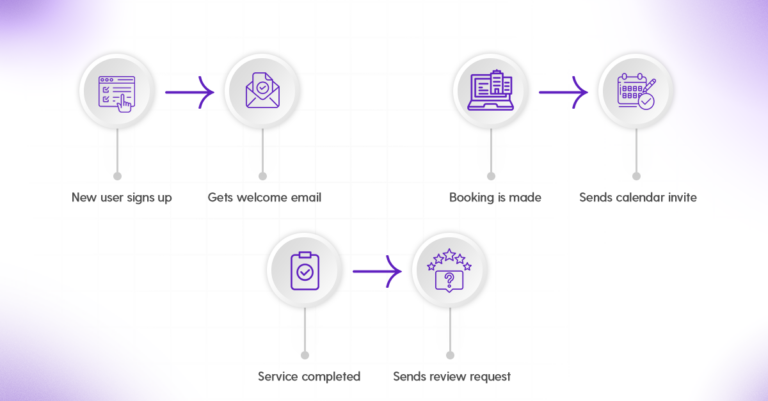
AI-Driven Matching & Dynamic Pricing Models
As your platform grows, users expect smarter results — faster. That’s where AI and dynamic pricing come into play.
AI-Driven Matching
The days of basic filters are gone. Today’s users expect your platform to understand their needs and deliver perfect matches.
With AI, you can:
- Rank providers by success rate, proximity, and user preferences
- Recommend services based on past behavior
- Predict booking success and time availability
Dittofi lets you connect to AI tools and models via APIs — meaning you don’t need to build your own ML engine from scratch. Just plug, play, and personalize.
Dynamic Pricing
Uber, Airbnb, even grocery delivery apps all use it. Dynamic pricing allows you to:
- Adjust pricing based on supply and demand
- Offer discounts during low-demand periods
- Encourage more bookings during off-peak hours
This isn’t just about being clever — it’s about staying competitive and giving users what they want, when they want it, at the price they’re willing to pay.
The hard truth? Most service marketplaces struggle during this phase — not because of bad ideas, but because of bad systems. With Dittofi’s hybrid no-code flexibility, you can build workflows, integrations, and automations that grow with you — not against you.
3 Marketplace Startups That Went from Zero to Millions — and How They Did It
Alright, theory’s nice — but what really makes people lean in? Stories. Especially stories of real companies that went from nothing to something massive. Let’s dive into three inspiring service marketplace case studies, breaking down exactly how they grew, solved real challenges, and scaled with smarts.
Case Study 1: A Niche Skill-Sharing Platform
Let’s talk about a small startup called CraftsyHub — a peer-to-peer marketplace for craft hobbyists to teach and learn skills like knitting, pottery, and watercolor painting.
The Growth Strategy:
CraftsyHub started by targeting hyper-specific Facebook groups and Reddit communities. They launched with just 10 teachers and a few dozen beta users, but focused entirely on creating amazing experiences. Their secret sauce?
- Live online classes with instant feedback
- Weekly “Skill Challenges” that kept users coming back
- An aggressive referral program: teachers got $10 for every new student that booked a class
The Tech Edge:
They built their MVP, using:
- Custom forms to onboard new instructors
- Real-time messaging between students and teachers
- An automated review + refund system that kept trust high
The Results:
In six months, they had 5,000 users and $20,000 in monthly revenue. By the end of year one? They were acquired by a major ed-tech platform.
Lesson: Find your tribe, delight them, and scale with automation—not burnout.
Case Study 2: A Regional Home Services Marketplace
Next up is CleanLoop, a marketplace for cleaning professionals in mid-sized U.S. cities. Unlike national giants, CleanLoop focused on local trust and convenience.
The Playbook:
They started by offering flat-rate pricing and “instant booking” for house cleaning in just three metro areas. Growth came from:
- Heavy investment in local SEO and Google My Business
- Partnering with local influencers and mommy bloggers
- Offering customers a 100% satisfaction guarantee
They also launched a membership plan: customers who booked 3+ cleanings a month got discounts and priority booking.
The Outcome:
From $0 to $100K MRR in 18 months. They now operate in 25+ cities and maintain a 92% retention rate.
Lesson: Start small, own your market, and use tech to out-service your competition.
Case Study 3: A virtual Freelance Marketplace
Last, we’ve got RemoteSprint, a platform that connects remote workers with short-term, agile team gigs.
Their edge? Speed. Startups could post a project and get matched with a vetted, remote team in under 48 hours.
Growth Tactics:
- Built a waitlist of 5,000 freelancers through early content marketing
- Used paid LinkedIn ads to attract SaaS startups looking to scale quickly
- Implemented a “pay on milestone” escrow model that built client trust
Results:
They crossed $1M in marketplace transactions within their first 9 months and are currently raising a seed round to build AI features in-house.
Lesson: If you solve for speed and trust, you’ll always have customers.
These aren’t unicorns — they’re startups that used clarity, focus, and the right tools to scale smart. You can do the same. Whether you’re in home services, education, healthcare, or something entirely new — you’ve got this.
Conclusion: Building the Future of Service Marketplaces
Let’s wrap this all up.
You’re no longer guessing — you’re deciding. Growth is no longer an experiment — it’s a system. And scaling? It’s not magic. It’s the result of choosing the right strategies, tools, and mindset at the right time.
To get your first 1,000 users, you’ll need hustle, storytelling, smart acquisition (SEO, ads, influencers), and built-in virality with referrals.
To scale, you’ll need automation, AI, and trust systems that keep your marketplace lean, fast, and secure.
To monetize, you’ll need pricing models and operational flows that convert value into profit — without burning your team out.
And the foundation of all of it? A flexible platform like Dittofi that grows with you, not against you.
You’re building something big. Let’s make it unstoppable.
Discover how Dittofi can help you scale smarter, not harder.
Struggling to grow your service marketplace? Discover the proven strategies to win users, scale operations, and monetize without guesswork.

